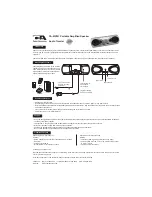
| 13
Weather
– Never operate your generator outdoors during
rain, snow or any combination of weather conditions that
could lead to moisture collecting on, in or around the
generator.
Dry Surface
– Always operate the generator on a dry
surface free of any moisture.
No Connected Loads
– Make sure the generator has no
connected loads before starting it. To ensure there are no
connected loads, unplug any electrical extension cords that
are plugged into the control panel receptacles.
NOTICE
Starting the generator with loads already applied to it could result in
damage to any appliance being powered off the generator during the
brief start-up period.
Grounding the Generator
– The National Electric Code (NEC),
as well as many local electrical codes, may require the generator
to be connected to earth ground. The most common application
that requires a ground rod is when you are using the generator
as a separately derived system to provide back up power to your
house. Typically this is when a transfer switch has a switched
neutral.
As the generator application has many variables that cannot
be determined by the manufacturer of the generator, a licensed
electrician will need to determine if a grounding rod is needed.
If a licensed electrician has determined the application requires
a ground rod, make sure it is connected to earth ground by
connecting the ground terminal on the control panel to earth
ground using copper wire (minimum 10 AWG). Consult a qualified
electrician for local grounding requirements.
WARNING
Be sure the generator is properly connected to
earth ground before operating. The generator must
be grounded to prevent electrical shock due to
faulty appliances.
High Altitude Operation
Engine power is reduced the higher you operate above sea
level. Output will be reduced approximately 3.5% for every
1000ft of increased altitude from sea level. This is a natural
occurrence and cannot be adjusted by engine. Increased
exhaust emissions can also result due to increased fuel
mixture. Other issues include hard starting, increased fuel
consumption and spark plug fouling.
BEFORE STARTING THE GENERATOR
BEFORE STARTING THE GENERATOR,
REVIEW SAFETY SECTION STARTING ON
PAGE 5.
Location Selection
– Before starting the generator, avoid
exhaust and location hazards by verifying:
• You have selected a location to operate the generator
that is outdoors and well ventilated.
• You have selected a location with a level and solid
surface on which to place the generator.
• You have selected a location that is at least 6 feet
(1.8 m) away from any building, other equipment or
combustible material.
• If the generator is located close to a building, make
sure it is not located near any windows, doors and/or
vents.
WARNING
Always operate the generator on a level surface.
Placing the generator on non level surfaces can
cause the generator to tip over, causing fuel and
oil to spill. Spilled fuel can ignite if it comes in
contact with an ignition source such as a very hot
surface.
Prolonged exposure to engine exhaust can cause
serious injury or death. While charging a device
do not place on the exhaust side of the generator.
Extreme heat caused by exhaust can damage the
device, and cause a potential fire hazard.
NOTICE
Only operate the generator on a solid, level surface. Operating the
generator on a surface with loose material such as sand or grass
clippings can cause debris to be ingested by the generator that
could:
• Block cooling vents
• Block air intake system
OPERATION
Содержание HYBRID DUAL FUEL R4400DF
Страница 28: ...28 Version 07 05 18KD Rev2 RainierPower com...














































